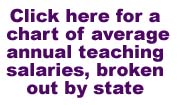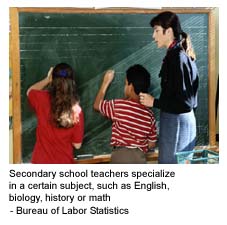|
'Working Your Degree'
|
 |
August 4, 2000: 5:48 a.m. ET
Employment for teachers expected to keep pace with national average
By Staff Writer Shelly K. Schwartz
|
NEW YORK (CNNfn) - If summer vacation tops your list of reasons for taking up teaching, Peggy Shaw says you've got a lot to learn.
The chairwoman of fine and performing arts at Falls Church High School in Fairfax, Va., and 23-year educator, said holiday perks aren't enough to keep you going if your heart isn't in it.
"This isn't something you put on at 8 a.m. and take off at 3:30 p.m.," she said. "It's a very demanding job. You don't keep banker's hours and you can't treat it as a career. You have to look at it as a vocation, because no matter where you are, in the classroom, on the beach or in a mall, you are going to be imparting knowledge."
Add to that the nights and weekends you'll spend grading papers, the lack of adult interaction and salaries only the dedicated could love - and Shaw insists the decision to teach must be motivated by something more.
"There comes a time when you know you are called to do certain things, like becoming a priest or ... in my case, a teacher," she said. "The money might not be there, but if you treat it as a vocation, the rewards won't always be monetary. It's going to be in seeing that you've touched the future of those you've taught."
Is that your final answer?
According to the Bureau of Labor Statistics, teachers in the K-to-12 grade levels held about 3.4 million jobs in 1998, the most recent year for which data are available.
Of those, roughly 1.9 million taught in kindergarten and elementary schools, and 1.4 million were secondary school teachers.
To become a teacher in the public school system, you must have a minimum of a bachelor's degree and complete an approved education program. You also must participate in a supervised practice teaching session.
Licensing by the state is required for public schools, though private  institutions have no such restrictions. institutions have no such restrictions.
However, Melinda Anderson, spokeswoman for the National Education Association in Washington, D.C., said it's worth noting that the required bachelor's degree does not have to be in education. A growing number of college grads with backgrounds in math and science are pursuing teaching careers these days as well.
"You do have to take the requisite education courses to teach, but education doesn't necessarily have to be your major," Anderson said. "There's been a real drive to recruit students from other majors."
Visit CNNfn's Career page regularly to read "Working your Degree," a new column that highlights a different college major each week, focusing specifically on the job opportunities that exist. Click here for last week's profile of the physical therapy job market.
Salary levels
Median annual earnings of kindergarten, elementary, and secondary school teachers ranged from $33,590 to $37,890 in 1998, depending on geographic location and school district, the Labor Department reports. The lowest 10 percent earned $19,710 to $24,390, while the top 10 percent brought in $53,720 to $70,030.
Teaching may be rewarding, but it's not a profession that lends itself to rapid payback of student loans.
The National Education Association reports that fledgling teachers, just starting out, can earn as little as $16,000, depending on location - a far cry from the $50,000-plus offers being thrown at computer science grads.
At the same time, a recent study by Education Week magazine found that teachers in their 20s earn an average $7,894 less than other college graduates their age. And to make matters worse, the pay gap widens as the years progress.
 Teachers aged 44 to 50, for example, earn an average of $23,655 less than their peers in other professions. And if they have a master's degree, they earn $32,511 less. Teachers aged 44 to 50, for example, earn an average of $23,655 less than their peers in other professions. And if they have a master's degree, they earn $32,511 less.
That alone, experts say, makes it tough to recruit teachers, and harder still to retain them.
"We are very concerned about this," Anderson said. "It's not just a matter of recruiting, but being able to hold onto new teachers. Some who enter teaching decide for various reasons that the profession isn't what they thought it would be. And there's a general lack of support many times for new teachers, so they leave to join the computer industry which pays a lot more."
Some 30 percent of new teachers leave the classroom within five years to pursue other career opportunities.
Looking ahead
The job market for teachers is a bit uneven. Demand for qualified educators in the inner cities, which frequently suffer from overcrowded classrooms and higher-than-average crime rates, remains steady, the Labor Department reports.
Demand is also high rural areas, which generally offer relatively low salaries and find it tough to attract top-tier teachers.
Jobs in both these regions are readily available.
School districts in the suburban neighborhoods are far more competitive, the government reports, though shortages of teaching staff still occur in certain subjects, including mathematics, science (especially chemistry and physics), bilingual education and computer science.
At present, there's an overabundance of qualified applicants in general elementary education, physical education and social studies.
"Teachers who are geographically mobile and who obtain licensure in more than one subject should have a distinct advantage in finding a job," the BLS Occupational Outlook states. "With enrollments of minorities increasing, coupled with a shortage of minority teachers, efforts to recruit minority teachers should intensify."
Generally speaking, employment for K-to-12 educators is expected to grow about 10 percent-to-20 percent through the year 2008, about as fast as the average for all occupations, the BLS states.
The imminent retirement of baby boomers, now in their 40s and 50s, will provide much of the fuel for that growth.
"The job market for teachers is very good right now," Anderson said. "They predict we're going to need about 2 million more educators over the next decade as (baby boomer generation) teachers retire. There is also going to be strong demand because of growing student enrollment and class reduction measures. The potential for employment in teaching has never been higher."
Looking for a teaching job? The American Association for Employment in Education, the industry's largest trade group, offers this helpful job-seeker's resource guide.
What they do
Teachers perform a multitude of tasks, varying dramatically depending upon the age group in which they specialize, the BLS reports. But all, for the most part, design classroom presentations, work with students individually, and plan, evaluate and assign lessons. Grading tests and reports, of course, also comes as standard operations.

In its Occupational Outlook report, the BLS also notes that classrooms increasingly are moving to smaller sizes - creating a more favorable student-to-teacher ratio. Many, too, are introducing group learning.
Most teachers put in more than 40 hours a week - including after-school activities, paper grading and school duties performed outside the classroom.
Since her first days in front of a classroom, Shaw has noted that much has changed - not all of it good.
"Prior to the 1970s, teaching was held in a somewhat higher regard," she said. "But because of a lot of factors, including salaries and stress of the job, it's not longer viewed as the best profession to get into."
Still, she insisted, there's no other job she'd rather do.
"I see the little faces that come into my classroom and I want them to know about art and become visually literate so that whether or not they ever take an art class again they'll be able to recognize a good painting and a good drawing," Shaw said. "It's rewarding to me because if I've done that, I've done an excellent job. "
Click here to send e-mail to the writer, Shelly K. Schwartz 
|
|
|
|
|
 |

|

